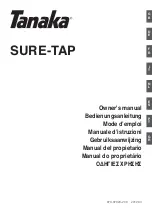
4 OF 7
·
Use only accessories that are recommended
by the manufacturer for your model.
Accessories that
may be suitable for one tool may create a risk of injury when used on another tool.
·
Keep guards in place
and in working order.
·
Never leave tool
running unattended.
·
USE COMPRESSED AIR ONLY.
Use clean, dry and regulated compressed air to power this tool.
Never use oxygen, carbon dioxide or any other bottled gas as a power source for this tool.
TOOL SET UP
Fig. 1 (Above) shows an optimal set-up that includes an inline filter, regulator and oiler. All of these
components are sold separately through Northern Tool + Equipment.
NOTE:
If you are not using an automatic oiler system, before operation, add a few drops of
Pneumatic Tool Oil to the airline connection. Add a few drops more after an hour of continual use.
1. Prepare the 1/4in. air nipple to connect to the air inlet on the Air Cutter. First, wrap the
1/4in. air nipple with pipe thread seal tape (not included) before threading it into the inlet.
Connect the 3/8in. I.D. air hose (not included) to a quick-disconnect coupler (not included)
and then to the air nipple.
2. Turn on the air pressure on your compressor to 90 PSI. Do not exceed the recommended
air pressure of 90 PSI.
3. Check the air connection for leaks.
AIR SUPPLY
WARNING:
Ensure the air supply is clean and does not exceed 90 PSI while operating the tool.
Too much air pressure and unclean air will shorten the product life due to excessive wear, and may cause
damage and/or personal injury.
1. Make sure that the air valve (or trigger) is in the “off” position before connecting to the air
supply.
2. An air pressure of 90 PSI is required.
3. Drain the air tank daily. Water in the airline can damage the tool.

























